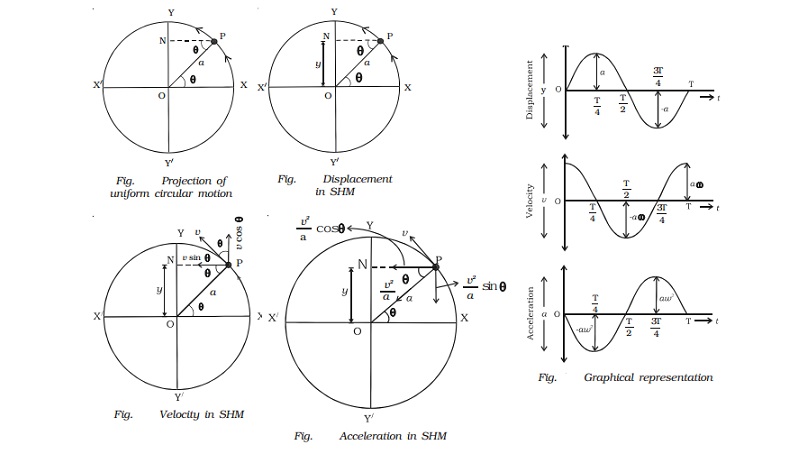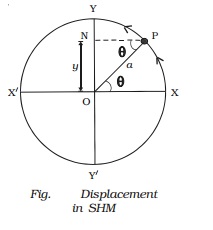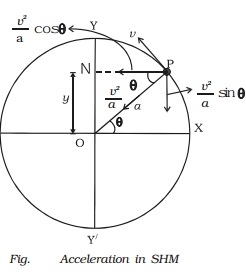Chapter: 11th 12th std standard Class Physics sciense Higher secondary school College Notes
The projection of uniform circular motion on a diameter is SHM

The projection of uniform circular motion on a diameter is SHM
Consider a particle moving along the Y
circumference of a circle of radius a and N P centre O,
with uniform speed v, in anticlockwise direction as
shown in Fig..

Let XX? and YY? be the two perpendicular
X diameters.
Suppose the particle is at P after a
time t. If ω is the angular velocity, then the angular displacement θ in time t
is given by θ = ωt.
From P draw PN
perpendicular to YY ? . As the particle moves from X to Y, foot of the
perpendicular N moves from O to Y. As it moves further from Y
to X ?, then from X
? to Y
? and back again to X, the point N moves from
Y to O, from O to Y ′ and back again to O. When the particle completes one revolution along the
circumference, the point N completes
one vibration about the mean position O.
The motion of the point N along the diameter YY ? is simple harmonic.
Hence, the projection of a uniform circular motion on a diameter
of a circle is simple harmonic motion.
Displacement in SHM
The distance travelled by the vibrating particle at any instant
of time t from its mean position is
known as displacement. When the particle is at P, the displacement of the particle along Y axis is y (Fig.).

Then, in ∆ OPN, sin θ = ON/OP
ON = y = OP sin θ
y = OP sin
ωt (∵ θ = ωt)
since OP = a, the
radius of the circle, the displacement of the vibrating particle is
y = a sin ωt ?.
(1)
The amplitude of the
vibrating particle is defined as its maximum displacement from the mean
position.
Velocity in SHM
The rate of change of displacement is the velocity of the
vibrating particle.
Differentiating eqn. (1) with respect to time t
Dy/dt = d/dt (a sin ωt)
∴ v = a ω cos ωt
...(2)
The velocity v of the particle moving
along the circle can also be obtained by resolving it into two components
as hown in Fig..

(i)
v
cos θ in a direction parallel to OY
(ii)
v
sin θ in a direction perpendicular to OY The component v sin θ has no effect
along YOY ′ since it is perpendicular to OY.
Velocity = v cos
θ = = v cos ωt
We know that,
linear velocity = radius ? angular velocity
∴
v = aω
∴
Velocity = aω cos ωt
∴
Velocity = aω root(1-sin2 ωt)
Velocity = ω.
Root(a2-y2)
Special cases
(i)
When the particle is
at mean position, (i.e) y = 0.
Velocity is aω and is maximum. v = + aω is called velocity amplitude.
(ii)
When
the particle is in the extreme position, (i.e) y = + a, the velocity is zero.
Acceleration in SHM
The rate of
change of velocity is the acceleration of the vibrating particle.
D2y/dt2
= d/dt(dy/dt) = d/dt(( aω cos ωt)
= −ω2
a sin ωt
acceleration = d2y/dt2
= ?ω2 y ??(4)
The acceleration
of the particle can also be obtained by component method.
The centripetal
acceleration of the particle P acting along P O is V2/a.

This
acceleration is resolved into two components as shown in Fig.
(i)
V2/a
cos θ along P N perpendicular to OY
(ii)
V2/a
sin θ in a direction parallal to YO.
The component v2/a cos θ has no effect along YOY ′ since it is
perpendicular to OY.
Hence acceleration = ? v2/a . sin θ
=
? a ω2 sin ωt
= − ω2 y
acceleation = − ω2 y
The negative sign indicates that the
acceleration is always opposite to the direction of displacement and is
directed towards the centre.
Special Cases
When the particle is at the mean position
(i.e) y = 0, the acceleration is
zero.
When the particle is at the extreme position
(i.e) y = +a, acceleration is ∓ a ω2 which is called as acceleration amplitude.

The differential equation of simple harmonic motion from eqn.
(4) is
D2y/dt2 + + ω2 y = 0
Using the above equations, the values of
displacement, velocity and acceleration for the SHM are given in the Table 6.1.
It will be clear from the above, that at the mean position y = 0, velocity of
the particle is maximum but acceleration is zero. At extreme position y = +a,
the velocity is zero but the acceleration is maximum ∓ a ω2 acting in
the opposite direction.
Graphical representation of SHM
Graphical representation of
displacement, velocity and acceleration of a particle vibrating simple harmonically
with respect to time t is shown in Fig..
(i)
Displacement
graph is a sine curve. Maximum displacement of the particle is y = +a.
(ii)
The
velocity of the vibrating particle is maximum at the mean position i.e v = + a
ω and it is zero at the extreme position.
(iii)
The
acceleration of the vibrating particle is zero at the mean position and maximum
at the extreme position (i.e) ∓
a ω2.
The velocity is ahead
of displacement by a phase angle of π/2 .
The acceleration is ahead of the velocity by a phase angle π/2 or by a 2phase π ahead of displacement.
(i.e) when the displacement has its greatest
positive value,
acceleration has its negative maximum value or vice versa.

Related Topics